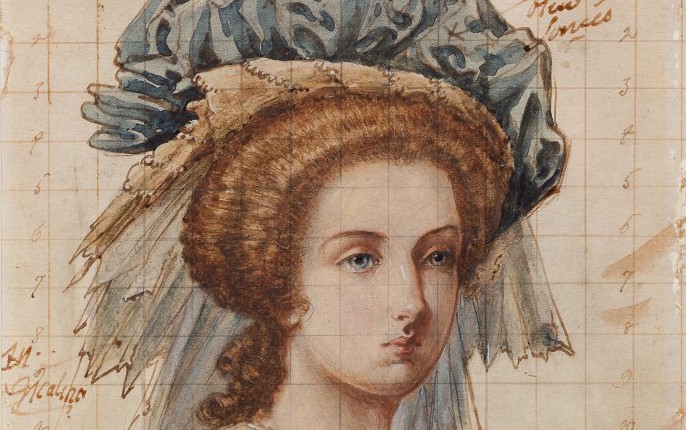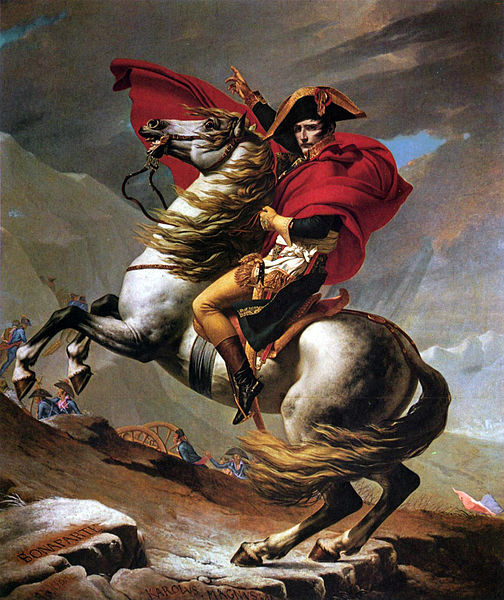
By Karie Jenkins, Clark Reading Room Assistant
You never know what great treasures you will come across at the Clark. When discussing the art collection with a colleague this morning, he informed me that we have two watercolor sketches of Marie Antoinette by Jacques-Louis David. The Death of Marat, perhaps David’s most famous painting, has been called the Pietà of the Revolution.

Intrigued and delighted by this snippet of information, I immediately had to see the drawings for myself. Within moments, I was whisked away to the Clark’s “French Green Room” where the sketches are hung adjacent to one another. Once we turned the corner and walked into the room we were greeted by the queen’s image, both faint and partial.
Both sketches seemingly accentuate Marie Antoinette’s exquisite sense of fashion and her imperial disposition. The first image I came across was of her standing and resting her hand gently on the back of a chair. The rendering of her attire and physique looks as though the sketch was taken straight out of a fashion illustrator’s notebook. Each garment is carefully labeled and assigned colors, thus demonstrating David’s creative process in composing this image. The second sketch is a portrait of Marie Antoinette. Detached and disinterested, she gazes away from the viewer with her head turned to the side. And naturally, her hair and head piece are piled high thus granting her the stature and royalty definitive to her essence. Of the two sketches, only the image of her standing is dated 1793, which was the ominous year she met her demise. Right above the date David wrote, “Marie Antoinette dans La Conciergerie.”
![131125_07: [Portrait of Marie Antoinette] [art original]. 1793.](http://clarklibrary.ucla.edu/wp-content/uploads/2014/04/marie-antoinette_original-a-small.jpg?w=450)
If you recall, Conciergerie was the infamous prison which Marie- Antoinette was brought before her trial. She was given less than a day to prepare and received no sympathy from the courts or the public. Once the verdict was reached, she was found guilty of treason and was immediately swept away to the guillotine. David had two months to sketch the queen while she was still alive and living in her cell. Even after she had long fallen from grace, David proceeded to imbue her image with the likeness of an angel or a saint. After all, she was the mother of France and what was a son to do?![131125_12: [Portrait of Marie Antoinette] [art original]. 179-?](http://clarklibrary.ucla.edu/wp-content/uploads/2014/04/marie-antoinette_original-b-small.jpg?w=450)
David’s sketches are fascinating and thanks to Professor Todd L. Larkin at Montana State University they have been the topic of discussion here at The Clark. Larkin contacted us requesting a reproduction of the sketches to which he encountered as a graduate student at UC Santa Barbara. On November 24th his request was fulfilled when a photographer came to The Clark to capture a couple of shots of the jail-bird queen. Unlike most pieces in our collection, the David sketches cannot simply be removed from their frames. A couple of years back, the library decided to bolt the frames to the walls in case of an earthquake to avoid any harm or damage to the sketches.
David’s Marie Antoinette sketches will permanently remain on display and we welcome our guests and scholars to stop by and admire them.



excellent post Becky,l Any info about MA attracts my attention. Thanks Patricia
While they are both lovely pieces, after doing my own research, the first sketch is most definitely not by David.
The first sketch is a copy with minor alterations of a painting by Jules Adolphe Goupil, who was born in 1839–more than a decade after David’s death. (The signature on this sketch also does not match David’s signatures.) An reproduction of said painting can be found here: http://i58.tinypic.com/kai7t4.jpg
While this sketch appears to have been altered to look more like Marie Antoinette, historically it does not match up with what we know about her life in the Conciergerie–where she had only one dress, her widows mourning gown and headdress, and certainly was not wearing the fluffy hats that donned her head in the late 1780s royal portraits.
The second image is less conclusive, because there are no dates or signatures that would help identify it, it becomes difficult. It does appear to be a copy of a portrait by Elisabeth Vigee-Lebrun, dated 1785. It was not unuusal at the time for artists to make copies of other artist’s work, but David post-1784 had just experienced a resounding success with ‘Oath of the Horatii,’ which earned him a rare place in the Louvre and at least two further commissions by Louis XVI. Would he have been spending his time on a copy of Lebrun’s work? It’s difficult to say, especially without further information, such as whether or not the unfinished/preparatory piece was commissioned, when it was created, who (if anyone) it was intended for, whether or not it is by the same artist as the first sketch, etc.
Thank you, Kyle! We will try to do some more digging at the Clark to find out more about the provenance of these paintings to see if they have always been attributed to David, or if there is other information from their time of purchase.
Hi Becky,
Where did this information come from regarding David spending time sketching Marie before her execution? I can’t seem to find any further info on this. Thank you for the clarification, Kyle.